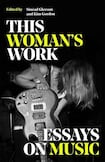
White Rabbit have become publishers as beloved as a record label, their titles inspiring the kind of devotion that results in purchase of the latest release regardless of the subject, be it the history of drone or the memoir of a singer.
Put White Rabbit together with Kim Gordon, visual artist, author and founding member of Sonic Youth, and bring into the mix Sinéad Gleeson, writer and indefatigable editor of several award-winning anthologies, and the result – an essay collection on women in music with 16 contributors – is bound to be a hit.
This Woman’s Work is billed as challenging “the historical narrative of music and music writing being written by men, for men” and “seeks to confront the male dominance and sexism that have been hard-coded in the canons of music, literature and film”. That’s laudable and very necessary, but it’s not anti-feminist to hope there is also also going to be irreverence, complication, thrills, ridiculous devotion, mystery and all the things that make the serious business of music so joyful. Glad to say, it’s all in there.
In her essay on rap, trap and drill, Simone White describes her profoundly physical response to particular tracks just before the bass drops. Her complex and fascinating essay considers how, while factoring in “perceptual effects of intense listening pleasure and disavowal”, this is still “party music of the dopest kind”.
Kim Gordon interviews musician Yoshimi Yokota with thrilled engagement, and Anne Enright's piece on meeting Laurie Anderson is a delight
So much of the book is about the sheer delight of being a fan. (Why does fandom get infantilised, in the fan girl/girl crush mode, as though admiration and attraction are the province of silly youngsters and not deeply adult behaviours?) In Praise Poem for Linda, Juliana Huxtable expresses what the vocals of Linda Sharrock mean to her. Through Sharrock, Huxtable’s own “complicated relationship to language, voice and sound” was rendered more understandable. Jenn Pelly writes about Lucinda Williams and Rachel Kushner on Wanda Jackson; their essays are attentive, personal, thoughtful.
Diaphoresis, Margo Jefferson’s contribution, begins with her as a child, playing records, before turning to address directly Ella Fitzgerald and her “ravishing, diaphoretic musicianship”. Kim Gordon interviews musician Yoshimi Yokota with thrilled engagement – “this is blowing my mind to hear!” – and Anne Enright’s piece on meeting Laurie Anderson is a delight. Meet your own personal icon and, like Enright, you might short-circuit.
Eight mixtapes
Music is part of the fabric of life in all of these essays. For Megan Jasper, that means working at record label Sub Pop, which she documents in her unstarry, funny essay. She’s not the label’s mum, she says. She relates more to “motherf**ker”. Music as part of the warp and weft is seen in Leslie Jamison’s account of eight mixtapes specific to different points of her life.
Sinéad Gleeson, in a great consideration of the work of Wendy Carlos, thinks about how her music became of even more acute significance during lockdown: “As Dublin’s streets remained quiet and remote, I listened again and again to The Shining [score], its dark lake, the roadside ululations.”
For Fatima Bhutto, music encapsulates, among other things, exile and loneliness. Away from her country, the pop anthem for a cricket league precipitates a “combination of bruised longing and joy”. Yiyun Li recalls summer in China when she was 13. She played Auld Lang Syne repeatedly on her accordion. And so, as music contingent on time and place, that song “played on a sultry July” had more meaning to her than “a chorus of Auld Lang Syne heralding a new year”.
The book closes with a tender essay by Zakia Sewell, articulating with aching candour how a crackling old tape recording immortalises a version of her mother
There are, in This Woman’s Work, beautiful pieces that focus on how music connects us to specific individuals. In Valentina, Ottessa Moshfegh remembers her old piano teacher: “She had no agenda beyond her love of music and carrying that on to others. She showed me that I had the capacity to feel and to think and make and to move others with what I make.” It’s a gorgeous essay.
Maggie Nelson writes about singer-songwriter Lhasa de Sela. Revered and famous, she was also a “goofy, struggling, often lonely human” – and Nelson’s brilliant friend. The book closes with a tender essay by Zakia Sewell, articulating with aching candour how a crackling old tape recording immortalises a version of her mother.
Bright and insightful
As the musician Heather Leigh states in her introduction, which is as bright and insightful as any of the contributions: “Music catches you. You can’t explain it, you have to experience it.” And while reading these passionate essays, I felt there was so much I wanted to experience, so much I hadn’t heard before.
This Woman’s Work presents such an array of trailblazers, geniuses, obsessives: Wendy Carlos as a child, building her own hifi system; sixth-grader Yoshimi experimenting with recording. But there is also hard, although at times undoubtedly pleasurable, graft. Liz Pelly, in her essay on Agnes “Sis” Cunningham, describes how the publication Broadside, “a zine before zine culture existed”, had its genesis. Sis Cunningham and her husband, Gordon Frieson, made it in their kitchen of their apartment in a housing project.
“We cleared the dirty dishes off the table,” Sis says, “and went to work…”
Wendy Erksine’s latest book is Dance Move (Stinging Fly Press)









